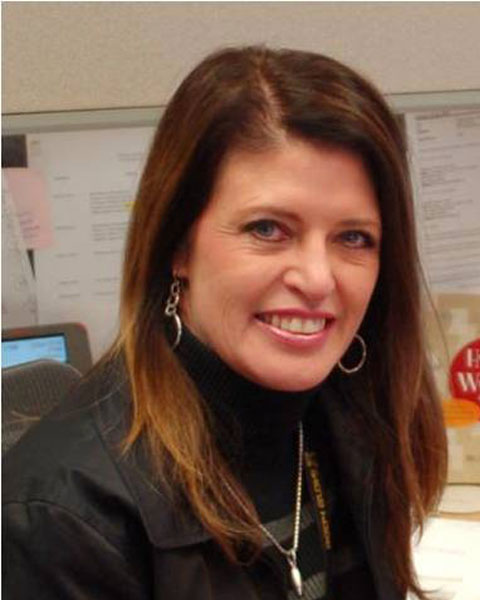Back
Abstract Session
Immunobiology
Session: Abstracts: B Cell Biology and Targets in Autoimmune and Inflammatory Disease (1629–1632)
1632: Novel Autoantibodies Identify Sjögren’s Disease in Patients Lacking Serum IgG Specific for Ro/SS-A and La/SS-B
Monday, November 14, 2022
9:45 AM – 9:55 AM Eastern Time
Location: Room 114 Nutter Theatre

A. Darise Farris, PhD
Oklahoma Medical Research Foundation
Oklahoma City, OK, United States
Presenting Author(s)
Sherri Longobardi1, Charmaine Lopez-Davis1, Bhuwan Khatri1, Constantin Georgescu1, Christina Lawrence1, Astrid Rasmussen1, Lida Radfar2, R. Hal Scofield2, Robert C. Axtell1, Gabriel Pardo1, Jonathan Wren1, Kristi A Koelsch1, Joel Guthridge1, Judith James1, Christopher Lessard1 and A. Darise Farris1, 1Oklahoma Medical Research Foundation, Oklahoma City, OK, 2University of Oklahoma Health Sciences Center, Oklahoma City, OK
Background/Purpose: Classification of Sjögren's disease (SjD) requires either Ro/SS-A autoantibodies or minor salivary gland biopsy positive for focal lymphocytic infiltrates. Up to 40% of SjD cases lack Ro autoantibodies. Here we used human proteome arrays to identify autoantibodies in Ro antibody negative SjD.
Methods: A discovery dataset was generated by testing SjD salivary gland plasmablast-derived monoclonal antibody pools (n=83 mAbs in 14 pools), stimulated parotid saliva (n=11 SjD), and plasma (n=30 SjD, n=15 HC) on human proteome arrays containing 15,500-19,500 proteins. A validation dataset was generated by testing plasma and stimulated parotid saliva from additional SjD cases (n=46 anti-Ro+, n=50 anti-Ro–), HC (n=42), and other disease (OD) controls (n=54) on custom arrays containing 150 proteins. For each protein, the mean + 3SD of the HC value was used as the threshold for positivity. Differences from HC were determined by Fisher's Exact test at p< 0.1 and by random forest machine learning and receiver operative curve (ROC) analysis, using 2/3 of the validation dataset to train and 1/3 of the validation dataset to test the ability of the model to assign subject status. Select proteins were additionally validated by capillary Western blot. Relationships among antigens were explored using STRING interactome analysis.
Results: Ro+ SjD parotid saliva contained antibodies binding to Ro60, Ro52, La/SS-B, and muscarinic receptor 5 (MR5). SjD plasma contained 13 novel autoantibody specificities, 11 of which were detected in both discovery and validation datasets. Binding to ³1 of the novel antigens identified 41% of Ro+ SjD cases and 54% of Ro– SjD cases. ROC analysis using binary (positive/negative) data and excluding binding to the canonical Ro60, Ro52 and La antigens showed ROC area under the curve (AUC) of 0.79 (95% CI 0.64-0.93) for distinguishing Ro– SjD cases from HC. Non-canonical autoantibodies could also distinguish Ro+ SjD cases (AUC 0.63, 95% CI 0.65-0.67) but not OD cases (AUC 0.37, 95% CI 0.31-0.31) from HC. STRING interactome analysis filtered on pathways including ³2 novel antigens identified leukemia cell, ubiquitin mediated proteolysis, antiviral defense, and cytosolic DNA sensing as possible pathways targeted by the autoimmune response in Ro– SjD.
Conclusion: We have identified novel antigenic targets of the autoantibody response in SjD that may be useful for identifying a substantial proportion of Ro seronegative SjD cases without a lip biopsy.
Disclosures: S. Longobardi, None; C. Lopez-Davis, None; B. Khatri, None; C. Georgescu, None; C. Lawrence, None; A. Rasmussen, None; L. Radfar, None; R. Scofield, None; R. Axtell, Progentec, EMD-Serono; G. Pardo, Bristol-Myers Squibb(BMS), Celgene, AbbVie/Abbott, Genentech, Janssen, Novartis, Roche; J. Wren, None; K. Koelsch, None; J. Guthridge, None; J. James, Bristol-Myers Squibb(BMS), AstraZeneca, Novartis, Progentec Biosciences; C. Lessard, Janssen; A. Farris, Janssen.
Background/Purpose: Classification of Sjögren's disease (SjD) requires either Ro/SS-A autoantibodies or minor salivary gland biopsy positive for focal lymphocytic infiltrates. Up to 40% of SjD cases lack Ro autoantibodies. Here we used human proteome arrays to identify autoantibodies in Ro antibody negative SjD.
Methods: A discovery dataset was generated by testing SjD salivary gland plasmablast-derived monoclonal antibody pools (n=83 mAbs in 14 pools), stimulated parotid saliva (n=11 SjD), and plasma (n=30 SjD, n=15 HC) on human proteome arrays containing 15,500-19,500 proteins. A validation dataset was generated by testing plasma and stimulated parotid saliva from additional SjD cases (n=46 anti-Ro+, n=50 anti-Ro–), HC (n=42), and other disease (OD) controls (n=54) on custom arrays containing 150 proteins. For each protein, the mean + 3SD of the HC value was used as the threshold for positivity. Differences from HC were determined by Fisher's Exact test at p< 0.1 and by random forest machine learning and receiver operative curve (ROC) analysis, using 2/3 of the validation dataset to train and 1/3 of the validation dataset to test the ability of the model to assign subject status. Select proteins were additionally validated by capillary Western blot. Relationships among antigens were explored using STRING interactome analysis.
Results: Ro+ SjD parotid saliva contained antibodies binding to Ro60, Ro52, La/SS-B, and muscarinic receptor 5 (MR5). SjD plasma contained 13 novel autoantibody specificities, 11 of which were detected in both discovery and validation datasets. Binding to ³1 of the novel antigens identified 41% of Ro+ SjD cases and 54% of Ro– SjD cases. ROC analysis using binary (positive/negative) data and excluding binding to the canonical Ro60, Ro52 and La antigens showed ROC area under the curve (AUC) of 0.79 (95% CI 0.64-0.93) for distinguishing Ro– SjD cases from HC. Non-canonical autoantibodies could also distinguish Ro+ SjD cases (AUC 0.63, 95% CI 0.65-0.67) but not OD cases (AUC 0.37, 95% CI 0.31-0.31) from HC. STRING interactome analysis filtered on pathways including ³2 novel antigens identified leukemia cell, ubiquitin mediated proteolysis, antiviral defense, and cytosolic DNA sensing as possible pathways targeted by the autoimmune response in Ro– SjD.
Conclusion: We have identified novel antigenic targets of the autoantibody response in SjD that may be useful for identifying a substantial proportion of Ro seronegative SjD cases without a lip biopsy.
Disclosures: S. Longobardi, None; C. Lopez-Davis, None; B. Khatri, None; C. Georgescu, None; C. Lawrence, None; A. Rasmussen, None; L. Radfar, None; R. Scofield, None; R. Axtell, Progentec, EMD-Serono; G. Pardo, Bristol-Myers Squibb(BMS), Celgene, AbbVie/Abbott, Genentech, Janssen, Novartis, Roche; J. Wren, None; K. Koelsch, None; J. Guthridge, None; J. James, Bristol-Myers Squibb(BMS), AstraZeneca, Novartis, Progentec Biosciences; C. Lessard, Janssen; A. Farris, Janssen.

